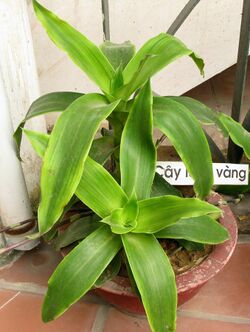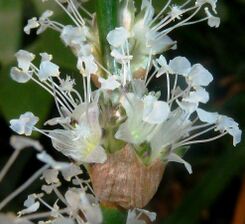Biology:Callisia fragrans
| Callisia fragrans | |
|---|---|

| |
| Scientific classification | |
| Kingdom: | Plantae |
| Clade: | Tracheophytes |
| Clade: | Angiosperms |
| Clade: | Monocots |
| Clade: | Commelinids |
| Order: | Commelinales |
| Family: | Commelinaceae |
| Genus: | Callisia |
| Species: | C. fragrans
|
| Binomial name | |
| Callisia fragrans (Lindl.) Woodson
| |
| Synonyms[1][2] | |
| |
Callisia fragrans, is a plant species of the genus Callisia, in the family Commelinaceae.[1]
Description
The fleshy stem of the herb grows to a height of 1 metre. 25-centimetre-long leaves become violet if exposed to strong sunlight. Blossoms are white and fragrant.[3][4]
Range and cultivation
Callisia fragrans, also called golden tendril is endemic to Mexico, and naturalized in the West Indies, scattered locations in the United States , and a few other places.[2][5] It has been cultivated in many countries as an indoor ornamental since the early 1900s.[6] However, it can be also found growing outdoors in warmer climates in moist, fertile soil. The herb likes partially shaded areas.
Medicinal properties
It has a rich folkloric reputation as an antiviral and antimicrobial plant. Especially in Eastern Europe, its leaves are used for treatment of various skin diseases, burns and joint disorders.[6] An ethanol leaf extract has been shown to effectively inhibit the infection of Vero cells by HSV-1, HSV-2 and an ACV-resistant strain of the latter, in vitro. The ethanol leaf extract, as opposed to an aquatic extract, was however ineffective against VZV.[6] Though the ethanol leaf extract had a lower selectivity index (toxicity vs. effectiveness) than ACV, it was able to inhibit the HSV-2 mutant, and may be less toxic than ACV. Direct interaction with the viruses and blocking of their access to the host cells seems to be involved.[6]
References
- ↑ 1.0 1.1 "Plants database". United States Department of Agriculture. https://plants.usda.gov/home/plantProfile?symbol=CAFR6.
- ↑ 2.0 2.1 Kew World Checklist of Selected Plant Families
- ↑ Klaus Kubitzki; H. Huber; P.J. Rudall; P.S. Stevens (1998). Flowering Plants. Monocotyledons: Alismatanae and Commelinanae (except Gramineae). Springer. p. 89. ISBN 3-540-64061-4. https://books.google.com/books?id=bNQDsSmx2roC&q=Callisia+fragrans&pg=PA115.
- ↑ "POTENTIAL ENVIRONMENTAL WEEDS IN AUSTRALIA". NATIONAL WEEDS PROGRAM. Queensland Department of Natural Resources. http://www.weeds.gov.au/publications/books/pubs/potential.pdf.
- ↑ "Ecology and Evolutionary Biology Plant Growth Facilities". University of Connecticut. http://titanarum.uconn.edu/198500190.html.
- ↑ 6.0 6.1 6.2 6.3 Yarmolinsky, Ludmila; Zaccai, Michele; Ben-Shabat, Shimon; Huleihel, Mahmoud (4 June 2010). "Anti-Herpetic Activity of Callissia fragrans and Simmondsia chinensis Leaf Extracts In Vitro". The Open Virology Journal 4 (1): 57–62. doi:10.2174/1874357901004010057. PMID 20700398.
External links
Wikidata ☰ Q9184292 entry
 |


